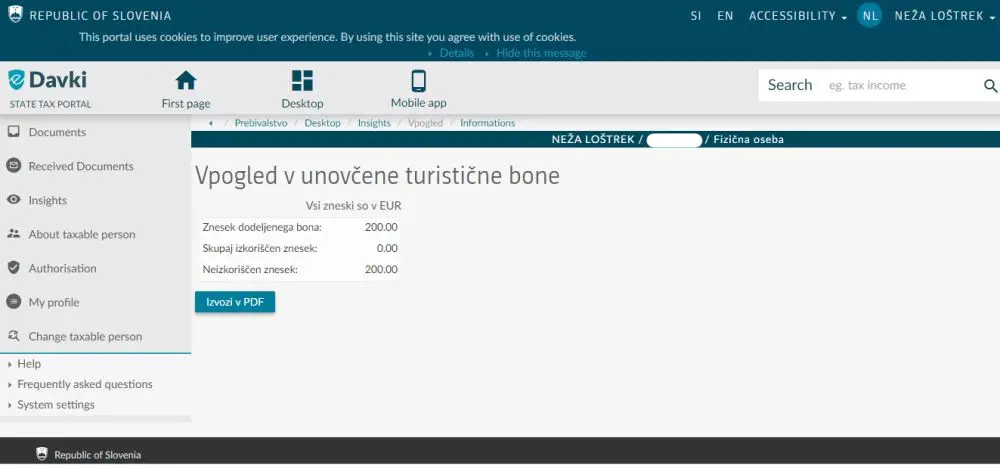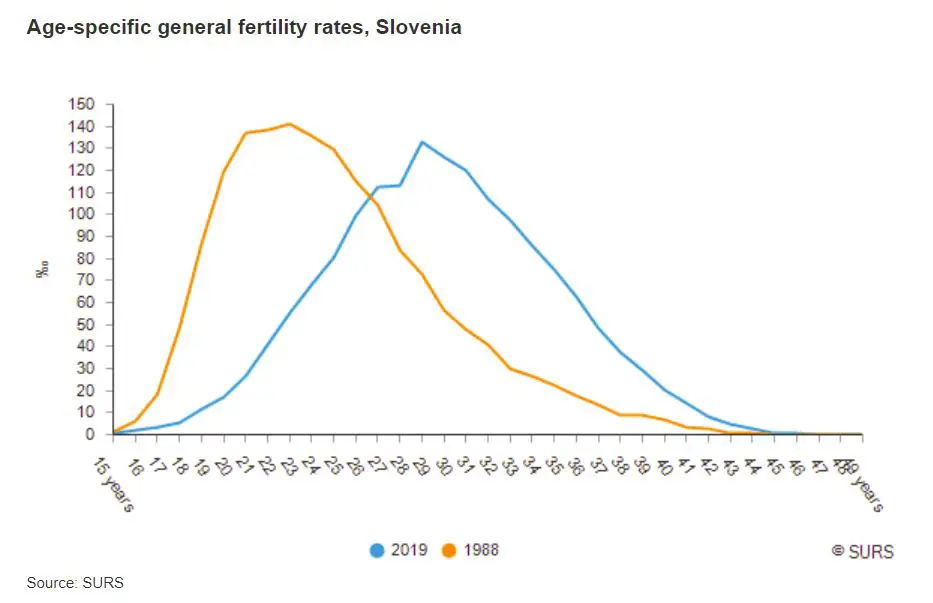Lifestyle
STA, 30 June 2020 - Contrary to previous announcements, Slovenia has decided not to delist Croatia as a Covid-19 safe country based on new assessments and steps taken by the country.
Jelko Kacin, the government spokesman, told reporters on Tuesday that even though the number of infections per 100,000 residents in Croatia has exceeded ten a day over the past fortnight, which merits the removal from the list, Slovenia believes Croatia will succeed in slowing down and eventually stopping the spread of infections in the coming days.
This is based on new assessments and Croatia's decision to close night clubs, venues that Kacin yesterday described as a major cause for concern.
"Based on an agreement between the countries' national [public health] institutes and a talk between both prime ministers, the Croatian government decided to adopt Slovenian action patterns and close night clubs as well as cancel such (massive) events," said Kacin, adding that Slovenia had hence come to a conclusion not to delist Croatia "at the moment".
He pointed out that Slovenia had given Croatia a chance to stem the spread of the infections by imposing the measures and thus lead by example among the Western Balkans countries.
Nuška Čakš Jager, the deputy head of the Centre of Infectious Diseases of the National Public Health Institute (NIJZ), earlier told the press that Croatia recorded 10.77 infections per 100,000 residents in the past two weeks.
Kacin pointed out that both countries kept regular contact on a daily basis, highlighting that removing Croatia from the list remained an option. Slovenia will keep closely monitoring the situation in the neighbouring country in cooperation with health experts, said the government spokesman, adding that the coronavirus spread trends were checked twice a day.
Interior Minister Aleš Hojs, who announced his resignation at the press conference, meanwhile said that the government had decided to keep Croatia on the list for now because the removal would "not change a thing for Slovenian citizens".
If Croatia was put on the yellow list, the Slovenian citizens would still be able to return to Slovenia from Croatia without having to quarantine, whereas Croatian citizens wanting to enter Slovenia would face different requirements. Only in case of exceptions they would not be required to undergo a mandatory 14-day quarantine.
The situation will be re-assessed at the end of the week, Hojs added.
Statements by Croatian and Slovenian officials however indicate that things are not clear-cut at present.
Croatian Interior Minister Davor Božinović told the press he had no knowledge of any promises to Slovenia to close night clubs, nor of any decision by Croatian authorities to do so.
He acknowledged, however, that such a possibility was on the table if night clubs became coronavirus hotspots.
And Slovenian Health Minister Tomaž Gantar told Kanal A in the evening that the decision not to delist Croatia was not prudent and was difficult to understand. "I don't know at which level the decision was taken," he said.
Hojs also commented on the EU list of Covid-19 safe third countries, saying that Slovenia would append a special statement to the document in which the country would state that it reserved the right to keep forming its own green, yellow and red lists.
Member states are expected to lift restrictions on the external border as of 1 July in case of certain third countries based on the list, however Hojs pointed out that the list was merely a set of guidelines and that it was up to individual EU countries to decide upon opening borders to third country citizens.
The EU has set down an average of 16 infections per 100,000 residents over a fortnight as a limit for declaring a country Covid-19 safe.
The NIJZ plans to keep the standard of 10 infections per 100,000 residents for Slovenia will not lower its standards, said Kacin, adding that the final decision on categorising countries according to their epidemiologic situations would be up to the government.
Among third countries that are expected to see lifting of border restrictions on the EU external border on 1 July are also Serbia and Montenegro, the two countries that have been put on the Slovenian red and yellow lists, respectively.
STA, 29 2020 - Various Slovenian cultural NGOs, institutions, festivals and artists are joining forces in a campaign called We are #Open (#odprti) for Culture, a joint platform aimed at raising awareness about the importance of culture. A series of events and action projects will highlight the role of creative endeavours in tackling current and future issues.
At today's press conference marking the launch of the campaign, Matevž Čelik Vidmar, the head of the Architecture and Design Museum (MAO), presented a study by the Centre for Creativity that stresses the role of culture in societal development as well as sustainable economy and dealing with the current burning issues.
"Culture and creative professions are those that could introduce new ideas into society and could be a laboratory for innovative concepts to find a way out of the crisis we are facing right now," he said.
Tibor Mihelič Syed, director of the Ljubljana SMG theatre, said that the joint project would in the long run strive to raise awareness about the role of the cultural, arts and creative ecosystem.
Apart from highlighting that cultural venues are reopening after the corona crisis, the campaign will also pursue long-term goals, such as creating a positive brand reminding the public that culture does not equal useless spending of public funds but is a set of positive values, said Tomaž Simetinger of the Slovenian Cultural Associations Union.
The first part of the campaign, #openstage (#odprtioder), will include some 100 free-of-charge events, taking place during the Slovenian Cinematheque summer open-air cinema between 1 July and 31 August. Museums are joining the action with extended opening times during summer and special events.
The programme, available on odprti.si web page [ed. at the time of writing the webpage was up, but there was no programme – you can follow #odprtioder on Twitter here, and the more general #odprti here], will feature various genres and strive to attract people who were not interested in such events prior to the corona crisis, said Uroš Korenčan, the head of the Ljubljana Puppet Theatre.
The efforts will strive to make a positive change not only in Ljubljana, but also in other Slovenian cities and towns, including Koper, Murska Sobota, Novo Mesto, Nova Gorica, Kranj and Celje. The campaign will try to actively involve other cities as well, leaving no one behind, said Inga Remeta, the head of the Asociacija NGO.
STA, 23 June 2020 - When it comes to greenhouse gas emissions not included in the EU emission trading scheme, Slovenia is expected to reach its goals for this year, shows a report released on Tuesday. The largest gaps remain in measures related to transport, in particular railway infrastructure and the promotion of public transportation.
The Climate Mirror 2020 (Podnebno Ogledalo 2020) report, compiled by the Environment Ministry and the Jožef Stefan Institute, says that Slovenia could be satisfied with the implementation of measures to improve energy efficiency of household- and municipality-owned buildings.
Related: Ljubljana Predicted to Be World’s Fastest-Warming City
Among other things, a positive mark has also been given to sorting of waste and the consequential reduction of the volume of landfilled biodegradable waste.
The report notes the increased effect of incentives for energy efficiency improvement of buildings in the public sector, as EUR 100 in investment required EUR 38 in grants, which is EUR 26 less than in 2015, mostly owing to municipalities.
The state has meanwhile not reached the set goals when it comes to buildings in its ownership, as they are being refurbished to improve their energy efficiency at an annual pace of 1.2%, compared to the target of 3%.
The report also says that industry has been neglected in this respect for a long time, with progress detected only in 2018, when the Eco Fund offered grants for the first time for this sector.
Measures for boosting efficient energy use and consumption of renewable sources in industry should be brought to a much higher level and goals for reducing emissions should be clearly defined, it adds.
The largest gaps are seen in measures related to transport, in particular railway infrastructure and the promotion of public transportation.
In 2018, practically all indicators for transport worsened, while progress was detected in sustainable mobility projects prepared by municipalities as part of incentives of the current EU financial perspective.
Coming second in terms of emissions with 15.6% is agriculture, with the report noting that measures in this field should be more focused on reducing methane emissions and upgrading measures for improving the efficiency of nitrogen circulation.
Greenhouse emissions from waste were down by 7.4% in 2018, mostly owing to increased sorting of solid waste and construction of systems for mechanical biological processing of municipal solid waste before being landfilled.
Progress has also been made in treatment of waste water, as the share of advanced systems has increased, the report adds.
Stane Merše of the IJS' Energy Efficiency Centre said that the period until 2030 would be key for the implementation of measures, adding that "if we are successful, climate change will be manageable still."
According to him, energy efficiency improvement of buildings, use of renewables and sustainable mobility should remain the basis, while incentives for industry and transport also need to be increased.
Tanja Bolte of the Environment Ministry said that the report "shows that we are on the right track of reaching the goal of reduced emissions, but also that measures need to be enhanced", and that the "present moment is decisive."
A PDF of the full report, in Slovenian, can be found here
In 1945 the RTV Slovenia Big Band (Big Band RTV Slovenija) performed for the first time during the reopening ceremony of Postojna Cave at the end of the war.
Immediately after liberation, the conductor and composer Bojan Adamič, who had his own orchestra during the Second World War, began to gather musicians for his new band called the Dance Orchestra of Radio Ljubljana. Their first public performance happened on June 27, 1945 at the reopening of Postojna Cave. The Dance Orchestra of Radio Ljubljana, officially became part of Radio Ljubljana in the autumn of that year. In the period that was not in favor of "American imperialist" music, Adamič skillfully introduced jazz elements into the otherwise rather "socialist" repertoire and successfully conducted the orchestra for sixteen years.
In 1961, Adamič was succeeded by Jože Privšek, who managed to raise the Big Band to the top of European entertaining and serious music standards. Over the decades of its operation, the Big Band of RTV Slovenija has also organized a number of concerts and successful tours around Europe, recorded many albums, and above all made a decisive contribution to the development of jazz, instrumental and vocal pop music. You can follow them on Facebook here.
STA, 26 June 2020 - The National Institute for Public Health (NIJZ) has highlighted on the occasion of International Day against Drug Abuse the problem of widespread cannabis use among Slovenian adolescents. An international study places Slovenia among the countries with the highest shares of 15-year-olds using cannabis.
The institute pointed to the 2018 HBSC (Health Behaviour in School-Aged Children WHO collaborative cross-national survey) report that showed an average of 13% of 15-year-olds in the 45 participating countries have already used cannabis. The share for Slovenia is 21%, which ranks the country 7th, the NIJZ said.
Related: Talking with the Slovenian Cannabis Social Club (SKSK) About Its Aims & Achievements
Slovenia fares even worse when it comes to 15-year-olds who have used cannabis in the 30 days before being quizzed for the survey. The international average is 7%, while it is 13% in Slovenia, which places the country only behind Canada and Bulgaria.
The NIJZ listed relative ease of access as one of the reasons for widespread use of cannabis among Slovenian youngsters. The survey has half of the 15-year-old Slovenian respondents assessing they could obtain cannabis easily or very easily within 24 hours.
Related: Learn Slovenian With Cannabis
The institute stressed the importance of preventive activities, such as equipping young people with proper social, emotional and behavioural skills, and measures aimed at reducing access to drugs, while stressing the use of cannabis among young people is harmful for brain development.
"Research has shown that with children and youngsters cannabinoids affect the development of the part of the brain responsible for the processing of received information and for thought processes helping solve problems and taking decisions. With regular use, these capacities are reduced, especially for those who start using this drug before the age of 18," Ada Hočevar Grom of the NIJZ warned.
Moreover, some research links the use of cannabis to poorer school performance and to the increased risk of the abuse of other drugs and addiction.
STA, 25 June 2020 - The number of asylum request filed in Slovenia increased by 33% to 3,820 last year, while the total increase among EU members was 11% to 738,425, shows an annual report published on Thursday by the European Asylum Support Office (EASO).
EASO pointed out that 2019 had been the first year after 2015 to see an increase in the number of applications at the annual level. It added the reasons included a 103% rise in applicants from Venezuela and a 214% increase in asylum seekers from Columbia. While some countries received more applications than in 2015, Germany stood out with 165,615.
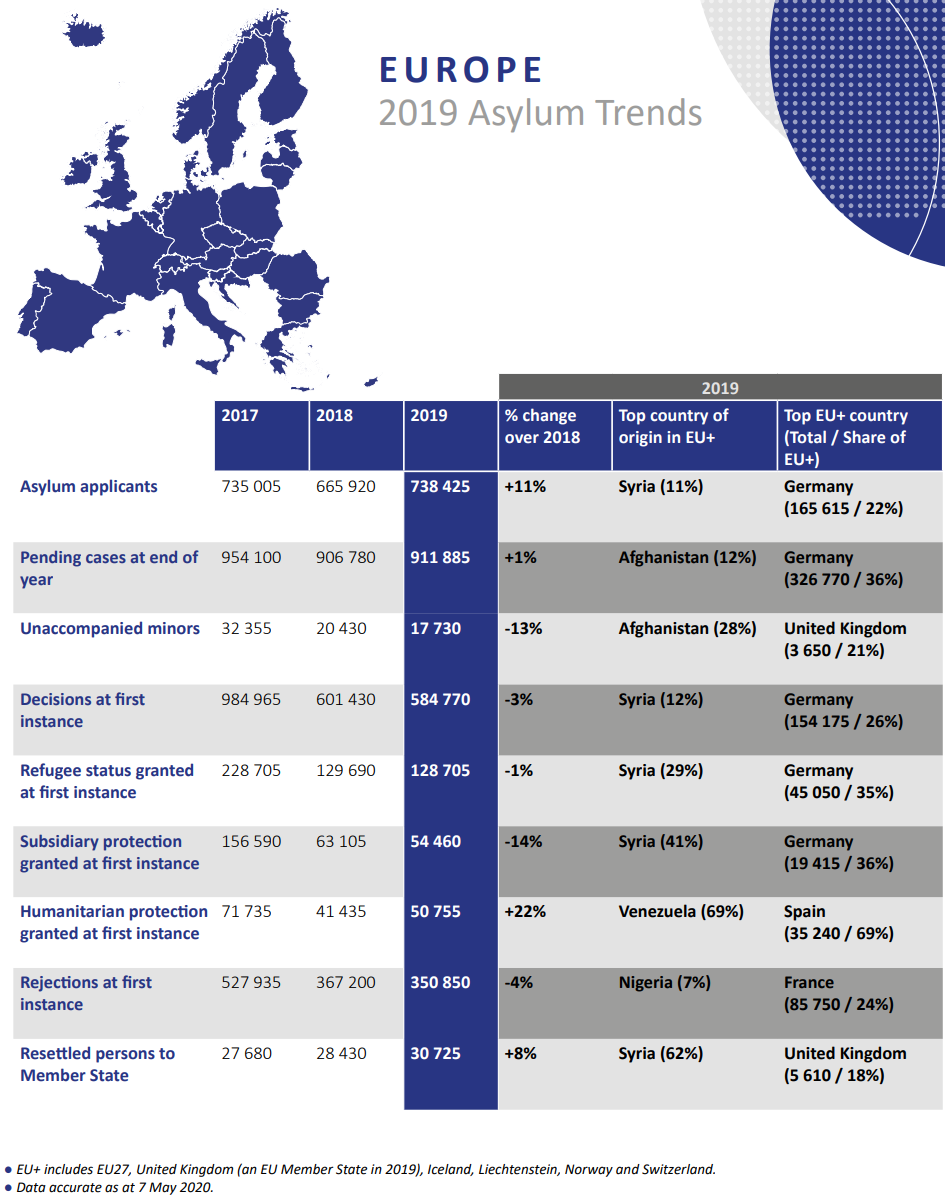
The largest share among the asylum seekers in the EU (11%) was accounted for by Syrians, followed Afghans (8.2%) and Venezuelans (6.2%), while Algerians topped the list in Slovenia.
Around 30,700 persons came to the EU last year as part of the relocation scheme, which envisages the admitting of 50,000 migrants. Slovenia accepted no migrants as part the scheme last year. For the third year running, Syrians made up about two-thirds of the persons relocated, EASO said.
There were 912,000 unresolved applications at the end of last year, significantly more than in the pre-2015 period, which the office said shows the pressure that asylum systems continue to operate under. In Slovenia, the number of unresolved cases at the end of last year was 530, a 30% increase on the year before.
The full report, in PDF form
STA, 23 June 2020 - A total of 19,328 children were born in Slovenia in 2019, 1.3% fewer then the year before, but the birth rate remained at 1.61. The number of deaths, at 20,588, exceeded the number of births for the third year running, show data released on Tuesday by the Statistics Office.
This is the second year in a row that fewer than 20,000 children were born in Slovenia after the figure had been exceeded for ten consecutive years prior to 2018.
At 9,977, the number of boys born fell short of 10,000 for the first time in 12 years. The number for girls, already below 10,000 in 2016, was 9,351.
One of the reasons for the declining number of births in recent years lies in an increasing number of women putting off the decision to have their first child. The average age increased again last year, to 29.6 from 29.5, while this compares to 23 three decades ago.
This also pushes up the average age of the mothers of newborns in general - it was 31.1 last year, while it stood at 25.9 in 1989.
Another reason is the decline in the birth rate seen in the 1980s and 1990s, which has led to a lower number of women aged between 25 and 34 at present.
Meanwhile, the parents of 57.7% of the 2019 newborns were not married. 16,175 children were born to parents who both had Slovenian citizenship and 1,339 to parents neither of whom had Slovenian citizenship.
Luka was the favourite name picked for boys for the 21st year running, being given to 2.8% of the newborns, while Zala made it back to the top among girls with 2.9%.
Meanwhile, the number of the deaths increased by 0.5% compared to 2018. The average age of the deceased exceeded 78 for the first time last year, reaching 78.1. It was 73.9 for men and 82.1 for women. In the last decade, the average for men increased by 3.8 years and for women by three years.
According to the Statistics Office, boys born last year can expect to live until they are 78.5, while the life expectancy for girls is 84.2. In the last ten years, the figures have increased by 9.1 and 7.1 years, respectively.
The share of so called premature deaths, meaning before the age of 65, was 16% last year - 22.4% among men and 9.8% among women. The gap between men and women in this category has been shrinking in the last decade. In 2009 the share for men was 30.8% and for women 12.4%.
The infant mortality rate last year was 2.1 deaths per 1,000 live births. The rate has been decreasing in Slovenia in the last decade and is among the lowest among EU member states.
More stories on demographics in Slovenia, while you can see more on births in Slovenia in 2019 here
STA, 25 June 2020 - Slovenia's population is ageing, while the number of residents is increasing on the back of immigration, show data for the 1991-2020 period published by the Statistics Office to mark Statehood Day. The state of the Slovenian economy is improving since the country declared independence, as are connections with foreign markets.
Marking Statehood Day on 25 June, the day in 1991 when Slovenia declared independence from Yugoslavia, the Statistics Office said that on 1 January 2020, Slovenia had 2,095,861 residents or 15,000 more year-on-year.
There were 1,051,066 men and 1,044,79 women, with men outnumbering women primarily because of the growing number of immigrants, who are mostly men.
Slovenia's population has been increasing in the last 25 years, as has its average age. At the beginning of 2019, the average age of a Slovenian resident was 43.4, which is two years more than ten years ago. A fifth of Slovenians are aged 65 or older.
Following the declaration of independence, Slovenia's economy experienced a blow as it lost the ex-Yugoslav market, introduced market economy and faced a high inflation rate. It was almost 250% in 1991, and it took four years to drop below 10%.
In 1991, Slovenia's gross domestic product (GDP) dropped in real terms by 8.9%, and by a further 5.5% in 1992. After a longer and relatively stable period, it was down by 7.8% in 2009 at the peak of the global economic and financial crisis.
Up until this spring, the Slovenian economy was recovering at an annual pace of between 3% and 5%. In the first quarter of 2020, the country's GDP was meanwhile down by 2.3% compared to the same quarter last year.
In the first quarter of the year, the very end of which was also marked by the coronavirus epidemic, foreign and domestic demand was also down.
In terms of GDP per capita, Slovenia placed 16th last year among the 28 EU member states.
Germany has remained Slovenia's most important trade partner all these years, while within the EU, Slovenia's trade with Austria increased the most. Outside the EU, Slovenia has exported most of its goods to the countries of the former Yugoslavia and to China.
In the 1991-2020 period, the Statistics Office recorded the highest unemployment rate in the first quarter of 2011, at 11.1%, while the lowest rate, at 4%, was recorded in the last quarter of 2019, when only 41,000 persons were unemployed.
The number of tourists visiting Slovenia has been mostly increasing since 1991, reaching a record 6.2 million last year. The figures are expected to be much lower this year as tourism was ground to a halt in mid-March and is still recovering.
You can see more on these statistics here
Last week the Minister of Justice Lilijana Kozlovič visited Ig female prison where she was also presented with the annual report from the National Prison Administration (Uprava za izvrševanje kazenskih sankcij) for the year 2019.
Ig prison is located in a 500 years old castle building for which a renovation and extension is planned. The works are supposed to commence in 2021, and the investment itself is expected to amount to more than 34 million euros. Apart from Ig, another prison is planned to be constructed in Dobrunje, where male prisoners from Povšetova in Ljubljana would be moved.
Last year, an average of 1,435 people were imprisoned in the Slovenian prison system, which is 6% more than the year before. This significant increase is largely due to those detained for those caught helping people to illegally crossing the state border. A significant increase in foreigners among inmates has been noticed as well, with non-Slovenes composing 30% of the entire imprisoned population.
The problem of overcrowding was partially solved by moving people between different institutions; however, prisons in Ljubljana, Koper, Novo mesto and Nova Gorica were still working over the limit of their capacity.
In her press statement Lilijana Kozlovič said that there was a possibility of introducing an alternative to prison sentences. She announced that a material basis would be created for a different kind of sentencing, namely penalties of non-confinement, where she sees great benefits in some already existing re-socialisation and community service programmes.
STA, 22 June 2020 - The Education Ministry is working on a number of possible scenarios for schooling regime in the next school year, Minister Simona Kustec told the press on Monday, saying everything would depend on the epidemiological situation. But school will definitely start on 1 September, she stressed.
Addressing the press after the first hundred days in office, the minister of education, science and sport said that active and intensive preparations for autumn were under way.
"We don't yet know what the epidemiological situation will be then but we must not be caught off guard," she stressed, noting that the models of education the ministry was working on were being formed based on experience gathered in the hundred days of remote learning.
The goal is to have as much schooling as possible conducted at school, Kustec said, noting that the final details were being ironed out regarding the possible models of schooling.
School principals were informed of this today, while a detailed presentation of the models will be sent to them at the beginning of July.
The decision on how school will actually start in September will be made in the last week of August, she said.
According to Radio Slovenia, the ministry is also working on a model envisaging a combination of remote learning and education at school for secondary schools under which a group of students would go to school for a certain period of time, while the other group would study from home, and then they would switch.
Most secondary school students finished this school year from home because of restrictions in public transport and student dorms, and it is assumed that those restrictions would remain in place in the autumn as well.
Kustec said the period between 16 March, when schools were closed, and 18 May, when the first three grades of primary schools returned to school, had been most "unusual".
But despite the peculiar circumstances, pupils and students will finish the year by meeting their obligations. "This process was a great challenge and we were successful because we joined forces, and together we understood what needs to be done and how to keep our lives going," she said.
Kustec and President Borut Pahor thanked everyone involved for their efforts in a video address on Sunday, with the president saying that this experience would be a story to tell children and grandchildren.
Looking into the future, Pahor said that undoubtedly new technologies would be even more important in the learning process than they were now. "But there is also no doubt that in the future school, teachers and learning will be more than just that."
He said school was also friends and crushes, teachers who guide their students, and parents and family members, who celebrate their successes and stand by their side in difficult times.
Kustec noted that EUR 18.8 million had been allocated to those affected by the coronavirus crisis in education as part of the three government-sponsored stimulus packages. Eight millions were spent on student bonuses, and another eight to help teachers in private and public kindergartens, student dorms and those employed in sport, she said.
Four days after the epidemic was declared on 12 March, 190.156 primary school children and 72,783 secondary school students switched to remote learning in Slovenia. After more than two months, the first three grades of primary schools returned to school on 18 May. Ninth-graders followed a week later and the remaining primary school children returned to school at the beginning of the month.
Since last Friday, it’s been possible for permanent residents of Slovenia to use their tourist vouchers as a form of payment for a accommodation facilities, and since they can be used in instalments residents who use the government’s e-services can follow their balance with Tax Office's E-Davki website and application.
Related: What You Need to Know about Slovenia’s Tourist Vouchers to Kickstart the Tourism Industry
Where can you to find it?
Enter into eDavki portal and sign in. Click your name in the upper right corner.
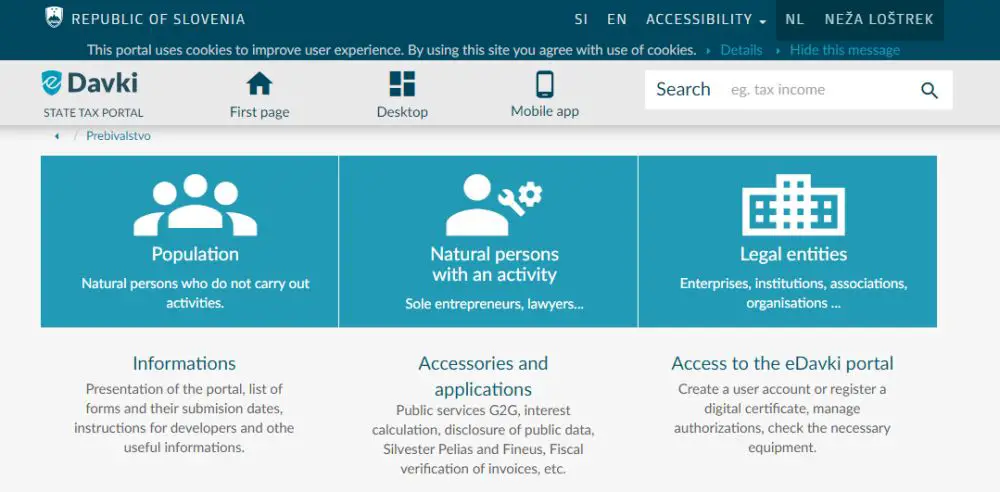
In case you’ve registered an S.P. you will have to choose your “natural person” (fizična oseba) account, or else the system will treat you as a potential service provider (as a “taxable person”) rather than a consumer.
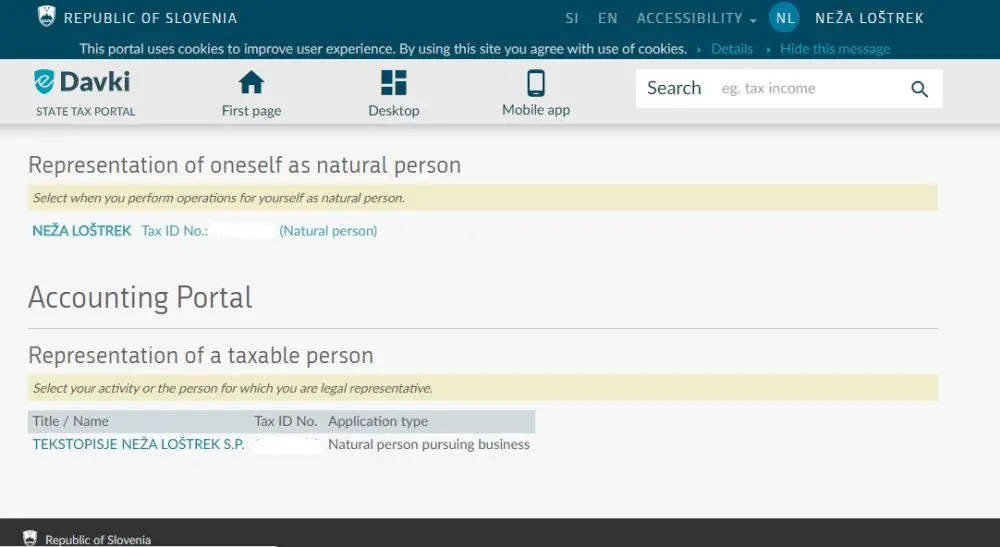
Choose ”Insights” (Vpogledi) in the left column.
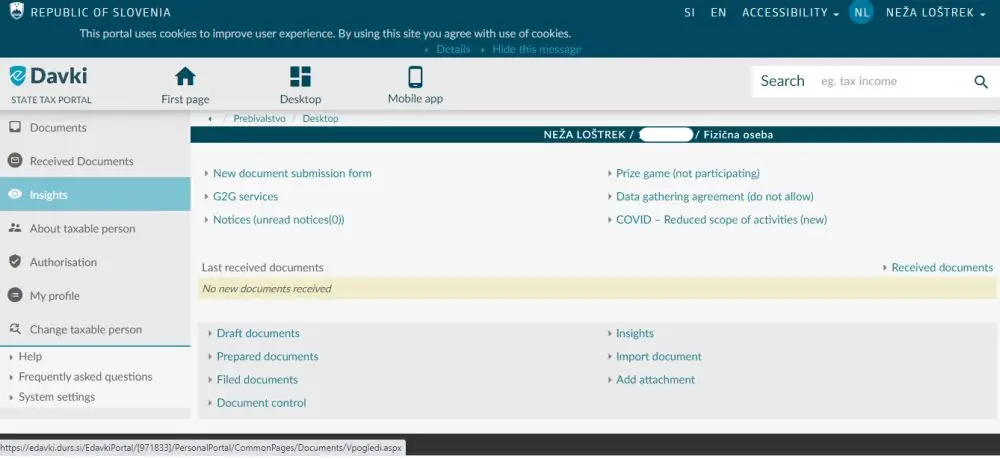
Scroll down to the “redemption of tourist vouchers” and click on “Insight into redeemed tourist vouchers”.
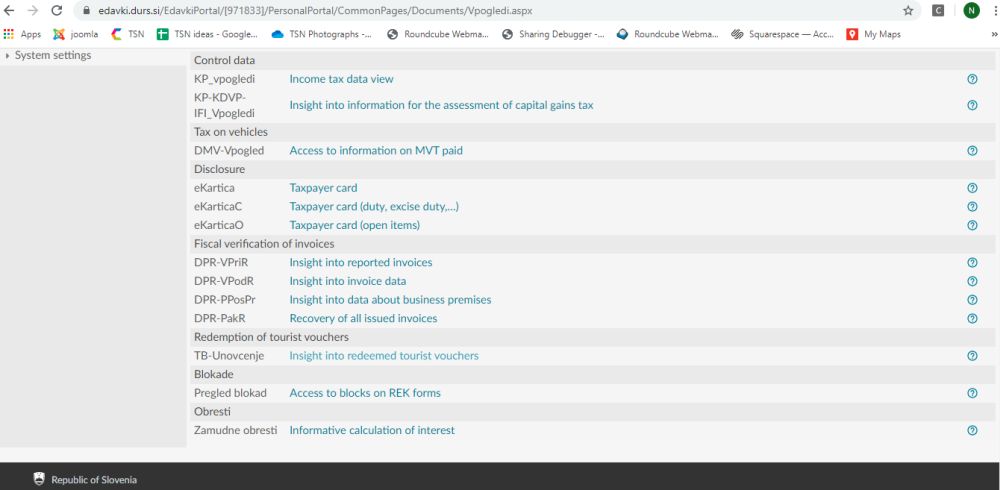
Here you’ll get the information on your current tourist voucher account.
